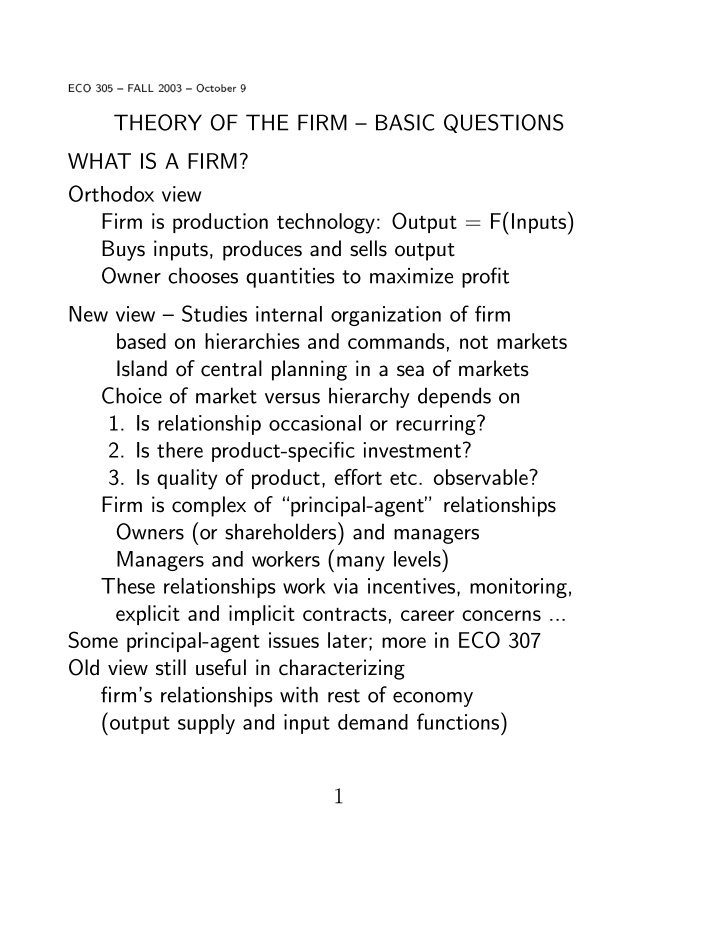



ECO 305 — FALL 2003 — October 9 THEORY OF THE FIRM — BASIC QUESTIONS WHAT IS A FIRM? Orthodox view Firm is production technology: Output = F(Inputs) Buys inputs, produces and sells output Owner chooses quantities to maximize profit New view — Studies internal organization of firm based on hierarchies and commands, not markets Island of central planning in a sea of markets Choice of market versus hierarchy depends on 1. Is relationship occasional or recurring? 2. Is there product-specific investment? 3. Is quality of product, effort etc. observable? Firm is complex of “principal-agent” relationships Owners (or shareholders) and managers Managers and workers (many levels) These relationships work via incentives, monitoring, explicit and implicit contracts, career concerns ... Some principal-agent issues later; more in ECO 307 Old view still useful in characterizing firm’s relationships with rest of economy (output supply and input demand functions) 1
TIME ASPECTS OF PRODUCTION 1. STOCKS AND FLOWS Production is a flow — quantity per period (month, year ...) Costs and profits should also be flows ($ per period) Some inputs are also flows — used up when used Raw materials, labor services Other inputs are stocks — machines, land ... Relevant input price is not their whole purchase cost but that of using their services for the period Actual or “imputed” cost of renting services: interest plus depreciation 2. SLOW ADJUSTMENT Not possible to adjust inputs optimally every instant Contracts with suppliers, laws against firing workers ... costs “sunk” — not avoidable by producing less or zero Distinction — fixed versus sunk Fixed: C (0) = 0 but as Q ↓ 0 , lim C ( Q ) > 0 Sunk: C (0) > 0 Longer timespan of analysis ⇒ fewer costs sunk Long run — no sunk costs (Free entry and exit) Short run — some costs sunk Marshallian convention — capital sunk, labor variable Very short run — All costs sunk, output supply fixed 2
PRODUCTION FUNCTIONS Read this in conjunction with the “graphics” handout. Output = F(Inputs), Technological data, exogenous Q = F ( K, L ) Examples: Cobb-Douglas: Q = K α L β Constant elasticity of subst’n: with β < 1 and γ > 0 , Q = [ a K β + b L β ] γ/β Similar to utility functions, but cardinal — scale of output has physical significance Marginal products ∂Q/∂K , ∂F/∂K , F K Diminishing marg. prod.s: ∂ 2 Q/∂K 2 < 0 , ∂ 2 Q/∂L 2 < 0 Average products Q/K , Q/L Diminishing returns to each factor: Q/K ↓ as K ↑ Returns to scale: For s > 1 , if F ( sK, sL ) > s F ( K, L ) , increasing returns to scale if = , constant; if < , diminishing Examples: Cobb-Douglas: ( s K ) α ( sL ) β = s α + β K α L β Returns to scale depend on α + β : incr. if > 1 , constant if = 1 , decr. if < 1 CES: [ a ( sK ) β + b ( sL ) β ] γ/β = s γ [ a K β + b L β ] γ/β Returns to scale depend on γ incr. if > 1 , const. if = 1 , decr. if < 1 3
Returns to scale in production and average cost linked Increasing returns to scale imply decreasing AC etc. Returns to scale can be first increasing, then decreasing (leads to U-shaped cost curves) Isoquant - Locus of ( L, K ) such that F ( L, K ) = constant Marginal Rate of Technical Substitution: � MRTS KL = − dK � = ∂Q/∂L � � dL ∂Q/∂K � Q = const Diminishing MRTS, serves as SOC for firm’s input-cost-min. Will show (also ECO 102) that cost-min implies MRTS KL = w / r w is the wage rate and r the price of using (renting) capital. Input substitution: as w/r ↑ , K/L ↑ along isoquant Elasticity of this function is elasticity of substitution Using Precept Week 3 work for CES utility function � L � β − 1 MRTS KL = b a K � a � 1 / (1 − β ) � w � 1 / (1 − β ) K L = b r so elasticity of substitution σ = 1 / (1 − β ) . 4
Recommend
More recommend